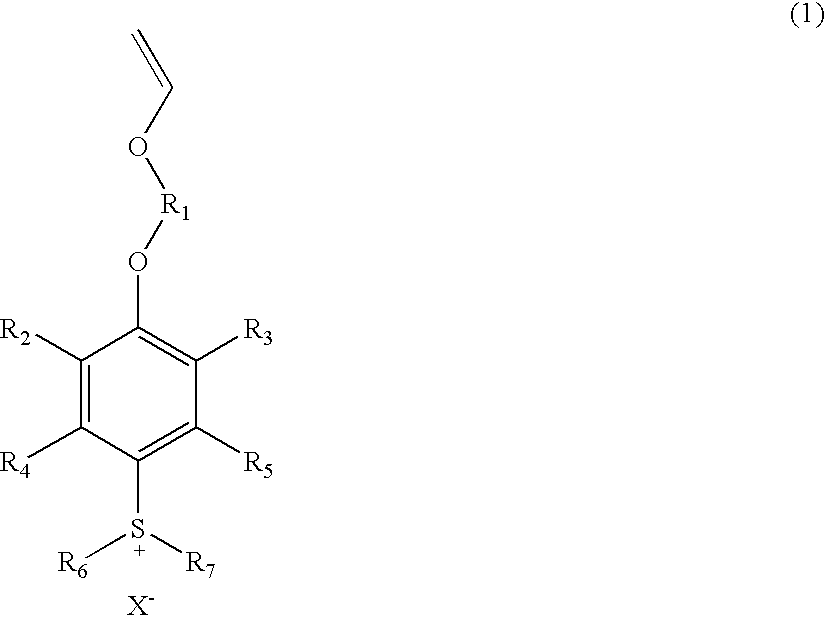Sulfonium salts
a technology of sulfonium salt and sulfonium salt, which is applied in the field of sulfonium salt, can solve the problems of poor compatibility with a photoresist polymer having an acid-dissociable group, and the shape characteristics of the obtained pattern are not satisfactory
- Summary
- Abstract
- Description
- Claims
- Application Information
AI Technical Summary
Benefits of technology
Problems solved by technology
Method used
Image
Examples
example 1
Synthesis of 4-vinyloxyethoxyphenyldiphenylsulfonium perfluorobutanesulfonate salt
[0030]
[0031]4-Hydroxyphenyldiphenylsulfonium perfluorobutanesulfonate salt (52.2 g), potassium carbonate (18.0 g), and N,N,N′,N′-tetramethylethylenediamine (1.05 g) were dissolved in dimethyl sulfoxide (26.1 g). Chloroethyl vinyl ether (13.9 g) was added to the solution, followed by heating to 80° C. The reaction mixture was stirred for 15 hours and cooled to 30° C. or lower. After removal of solid through filtration, water (100 g) was added to the filtrate, and the aqueous layer was washed three times with hexane (100 g). To the washed aqueous layer, dichloromethane (209 g) and water (260 g) were added under stirring, whereby the target substance was extracted to the dichloromethane layer. The organic layer was repeatedly washed with distilled water until the pH of the separated aqueous layer was shifted to 7. The solvent was removed by means of a rotary evaporator, to thereby yield 69.9 g of an oily ...
example 2
Synthesis of 4-vinyloxyethoxy-3,5-dimethylphenyldiphenylsulfonium perfluorobutanesulfonate salt
[0033]
[0034]4-Hydroxy-3,5-dimethylphenyldiphenylsulfonium perfluorobutanesulfonate salt (56.1 g), potassium carbonate (18.4 g), and N,N,N′,N′-tetramethylethylenediamine (1.07 g) were dissolved in dimethyl sulfoxide (118 g). Chloroethyl vinyl ether (14.2 g) was added to the solution, followed by heating to 80° C. The reaction mixture was stirred for 47 hours and cooled to 30° C. or lower. After removal of solid through filtration, water (280 g) was added to the filtrate, and the aqueous layer was washed three times with hexane (168 g). To the washed aqueous layer, dichloromethane (226 g) and water (50 g) were added under stirring, whereby the target substance was extracted to the dichloromethane layer. The organic layer was repeatedly washed with distilled water until the pH of the separated aqueous layer was shifted to 7. The solvent was removed by means of a rotary evaporator, to thereby...
example 3
Synthesis of 4-vinyloxyethoxyphenyldi(4-t-butylphenyl)sulfonium perfluorobutanesulfonate salt
[0036]
[0037]4-Hydroxyphenyldi(4-t-butylphenyl)sulfonium perfluorobutanesulfonate salt (28.4 g), potassium carbonate (8.56 g), and N,N,N′,N′-tetramethylethylenediamine (0.50 g) were dissolved in dimethyl sulfoxide (143 g). Chloroethyl vinyl ether (6.30 g) was added to the solution, followed by heating to 80° C. The reaction mixture was stirred for 15 hours and cooled to 30° C. or lower. After removal of solid through filtration, water (220 g) and dichloromethane (113 g) were added to the filtrate, whereby the target substance was extracted to the dichloromethane layer. The organic layer was repeatedly washed with distilled water until the pH of the separated aqueous layer was shifted to 7. The solvent was removed by means of a rotary evaporator, and the formed oily substance was dissolved in acetonitrile (100 g). The acetonitrile layer was washed five times with hexane (85 g). The solvent wa...
PUM
| Property | Measurement | Unit |
|---|---|---|
| organic | aaaaa | aaaaa |
| acid | aaaaa | aaaaa |
| density | aaaaa | aaaaa |
Abstract
Description
Claims
Application Information
 Login to View More
Login to View More - R&D
- Intellectual Property
- Life Sciences
- Materials
- Tech Scout
- Unparalleled Data Quality
- Higher Quality Content
- 60% Fewer Hallucinations
Browse by: Latest US Patents, China's latest patents, Technical Efficacy Thesaurus, Application Domain, Technology Topic, Popular Technical Reports.
© 2025 PatSnap. All rights reserved.Legal|Privacy policy|Modern Slavery Act Transparency Statement|Sitemap|About US| Contact US: help@patsnap.com



